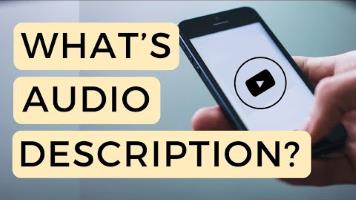What are Audio Descriptions?
Audio descriptions make videos accessible to learners who cannot see essential visual content—such as text, charts, graphs, diagrams, demonstrations, or gestures. Under WCAG 2.1 Level AA, this information must be conveyed through audio that plays in sync with the video, either integrated into the main narration or provided as an additional audio description track.
Example of Audio Descriptions
How Do Blind People Watch Videos? | What is Audio Description?

Solutions for Audio Descriptions
There are several ways to address the requirement for audio descriptions.
1. Natural Audio Descriptions: When scripting and recording a video, include descriptions of important (non-decorative) visuals into your narration. By describing the video visuals as you narrate, you are "baking in" the audio description for the video.
2. Extended Audio Descriptions: If your video has been pre-recorded, you can add audio descriptions to the video as a secondary audio track or via text-to-voice features in some video editors. This is known as an "extended audio description." Panopto, our University's video management platform, allows users to create extended audio descriptions by providing text to describe the visuals in the Panopto video editor. The extended audio description will play at the timestamp you set for each audio description. (Instructions below)
3. Replace the Video with an Alternative Format: If adding audio descriptions is not feasible, consider replacing the video with alternative formats that convey the same information without the need for audio descriptions.
Adding Audio Descriptions in Panopto
Panopto lets you add audio descriptions to your videos, and students can choose to enable or disable these audio descriptions based on their preferences.
Below are instructions for adding audio descriptions to your Panopto videos:
Instructions on how to add Audio Descriptions in Panopto
